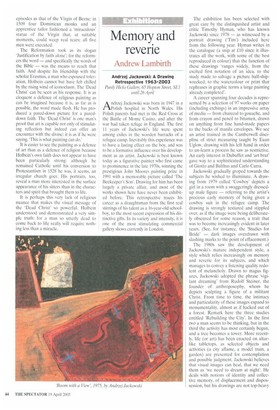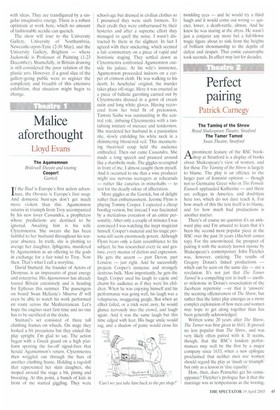Memory and reverie
Andrew Lambirth
Andrzej Jackowski: A Drawing Retrospective 1963-2003 Purdy Hicks Gallen:, 65 Hopton Street, SE] until 26 April
Acidrzej Jackowski was born in 1947 in a olish hospital in North Wales. His Polish parents had met in the Red Cross at the Battle of Monte Casino, and after the war had taken refuge in England. The first 11 years of Jackowski's life were spent among exiles in the wooden barracks of a refugee camp. Inevitably this experience was to have a lasting effect on the boy, and was to be a formative influence over his development as an artist. Jackowski is best known today as a figurative painter who first came to prominence in the late 1970s. winning the prestigious John Moores painting prize in 1991 with a memorable picture called 'The Beekeeper's Son". Drawing for him has been largely a private affair, and most of the works shown here have never been exhibited before. This retrospective traces his career as a draughtsman from the first real stirrings of his talent as a 16-year-old schoolboy, to the most recent expression of his distinctive gifts. In its variety and intensity, it is one of the most stimulating commercial gallery shows currently in London.
The exhibition has been selected with great care by the distinguished artist and critic Timothy Hyman, who has known Jackowski since 1978 — as witnessed by a portrait drawing ('Tim') included here from the following year. Hyman writes in the catalogue (a snip at £10 since it illustrates all the work, with some of the best reproduced in colour) that the function of these drawings 'ranges widely, from the excited first notation of an idea, to the study made to salvage a picture half-shipwrecked, to the watercolour or print that rephrases in graphic terms a large painting already completed'.
A career spanning four decades is represented by a selection of 97 works on paper (including etchings) in an impressive array of media — from charcoal to gouache, and from crayon and pencil to bitumen, drawn on anything from fine hand-made papers to the backs of manila envelopes. We see an artist trained in the Camberwell discipline of strict measuring taught by Euan Uglow, drawing with his left hand in order to un-learn a process he saw as restrictive. An early interest in Dubuffet and 'art brut' gave way to a sophisticated understanding of Giotto and Balthus and Carlo Carra.
Jackowski gradually groped towards the subjects he wished to illuminate. A drawing from 1979 called 'Cowboy' depicts a girl in a room with a swaggeringly dressedup male figure — referring to the artist's precious early memory of being given a cowboy suit in the refugee camp. The drawing is strongly textured and stippled over, as if the image were being deliberately obscured for some reason, a trait that was to become increasingly evident in later years. (See, for instance, the 'Studies for Bride' — dark images overdrawn with slashing marks to the point of effacement.) The 1980s saw the development of Jackowski's mature independent style, a style which relies increasingly on memory and reverie for its subjects, and which manages to convey a listening quality redolent of melancholy. Drawn to magus figures. Jackowski adopted the phrase 'vigilant dreaming' from Rudolf Steiner, the founder of anthroposophy, whom he depicts sculpting a figure of a militant Christ. From time to time, the intimacy and particularity of these images expand to monumentality, almost as if hacked out of a forest. Remark here the three studies entitled 'Rebuilding the City'. In the first two a man seems to be thinking, but in the third the activity has most certainly begun, and a tree becomes a tower. More recently, life (or art) has been enacted on altarlike tabletops, as selected objects and activities (a city aflame, a model train, a garden) are presented for contemplation and possible judgment. Jackowski believes that visual images can heal, that we need them as 'we need to dream at night'. He deals with notions of identity and collective memory, of displacement and dispossession, but his drawings are not top-heavy with ideas. They are transfigured by a singular imaginative energy. There is a robust optimism at work here, which no amount of fashionable accidie can quench.
The show will tour to the University Gallery, University of Northumbria, Newcastle-upon-Tyne (2-30 May), and the University Gallery, Brighton — where Jackowski is Professor of Painting (1-23 December). Shamefully, in Britain drawing is still considered the poor relation of the plastic arts. However, if a good slice of the gallery-going public were to register the complexity and breadth of this extensive exhibition, that situation might begin to change.



































































 Previous page
Previous page